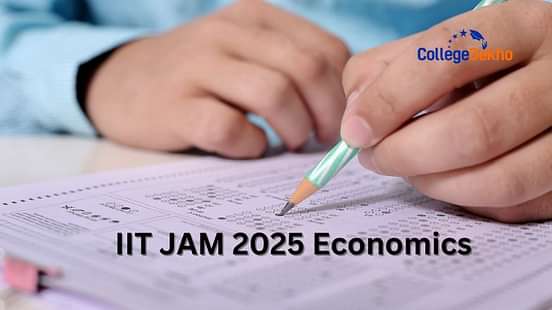IIT JAM Economics (EN) 2025 exam will be conducted on February 2, 2025 (Afternoon Session). View all the latest details about the exam, like important dates, in-depth syllabus, exam pattern, previous year papers, etc., here.

IIT JAM Economics 2025 (EN) covers topics from Microeconomics, Macroeconomics, Mathematics, and Statistics among others. Students must possess a strong analytical and mathematical ability to secure competitive marks. If you successfully qualify the entrance, you can get an exclusive chance to apply at renowned institutes and universities in India. For IIT JAM 2025 Economics(EN) paper, pay special focus on national income accounting, consumer theory, mathematical stats and Indian Economy policies. We advise test takers to gain enough familiarity with exam patterns as it will allow them to strategise study plans. Practicing IIT JAM previous year question papers and attempting mock tests can offer a competitive edge.
Read the following article to get information about the IIT JAM 2025 Economics exam dates, syllabus, and pattern, as well as how to download previous year papers for better preparation.
Also Read:
IIT JAM 2025 Exam Centres
IIT JAM 2025 Economics(EN) Eligibility Criteria
Before heading to the application process, you must review IIT JAM 2025 eligibility criteria for Economics paper. Each IIT will grant admissions considering their concerned admission rules. Here are some general eligibility guidelines that you must follow:
- Age: No age limit has been determined to participate in the examination.
- Qualification: Participants should have completed graduation in BA Economics or BCom with Economics from a recognised university.
- Marks requirement: To apply for IIT JAM EN, students must score at least 55%. Relaxations will be given to reserved candidates.
IIT JAM 2025 Important Dates
Candidates can check out all the important dates for IIT JAM 2025 in the table provided below:
Events | Dates |
|---|---|
Commencement of IIT JAM 2025 Registration and Application form | September 3, 2024 |
| IIT JAM Application Form 2025 Last Date | October 11, 2024 |
| IIT JAM 2025 Application Form Correction | November 18, 2024 |
| Upload of valid OBC-NCL certificate | November 20, 2024 |
IIT JAM 2025 Admit Card Download Date | January 6, 2025 |
IIT JAM 2025 Exam Date | February 2, 2025 |
IIT JAM 2025 Response Sheet | To be notified |
| IIT JAM 2025 Exam Answer Key | To be notified |
| Submission of Challenge for the IIT JAM Answer Key 2025 | To be notified |
IIT JAM 2025 Exam Result Date | March 19, 2025 |
| IIT JAM 2025 Score Card | March 25, 2025 |
Starting date of IIT JAM 2025 Application Form for Admission | April 2, 2025 |
IIT JAM Economics 2025 Exam Date
IIT Delhi will conduct the IIT JAM Economics 2025 exam. The exam will be conducted in an online mode. Admission to these programmes will be determined by the candidate's performance in the entrance exam. As the entrance will be conducted on February 2, 2025 (Afternoon Session), students must reach the respective exam centre at least 35 minutes before the commencement of the exam. IIT Delhi has already released IIT JAM 2025 admit cards on January 6, 2025. Carry your admit for IIT JAM Economics 2025 exam else you wont be allowed to sit for the exam.
IIT JAM Economics 2025 Syllabus
Candidates can check out the list of total chapters in IIT JAM Economics 2025 Syllabus which is divided into 4 parts Microeconomics, Macroeconomics, Indian Economy, and Mathematics for Economics.
IIT JAM 2025 Microeconomics Syllabus
Topics | Sub Topics |
|---|---|
Consumer theory | Preference, utility, and representation theorem, budget constraint, choice, demand (ordinary and compensated), Slutsky equations, choice under risk and uncertainty, revealed preference axioms |
Production, costs with perfectly competitive markets | Technology, isoquants, production with one and more variable inputs, returns to scale, short run and long run costs, cost curves in the short run and long run, perfect competition in markets |
General equilibrium and welfare | Equilibrium and efficiency under pure exchange and production, welfare economics, theorems of welfare economics |
Market structure | Monopoly, pricing with market power, price discrimination (first, second and third), monopolistic competition and oligopoly |
Game theory | Strategic form games, Nash equilibrium, mixed extension and mixed strategy Nash equilibrium, iterated elimination of dominated strategies, examples: Cournot, Bertrand duopolies, Prisoner’s dilemma, cooperative game theory: Shapley value, Nash bargaining |
Public goods and market failure | Externalities, public goods and markets with asymmetric information (adverse selection and moral hazard), VCG mechanism and transfer rules |
IIT JAM 2025 Macroeconomics Syllabus
Topics | Sub Topics |
|---|---|
National Income Accounting | Structure, key concepts, measurements, and circular flow of income - for a closed and open economy, money, fiscal and foreign sector variables - concepts and measurements |
Behavioral and Technological Functions | Consumption functions - absolute income hypothesis, life-cycle, and permanent income hypothesis, investment functions- Keynesian, money demand and supply functions, production function |
Business Cycles and Economic Models | Business cycles-facts and features, the Classical model of the business cycle. the Keynesian model of the business cycle, simple Keynesian cross model of income and employment determination and the multiplier (in a closed economy), IS-LM Model, Hicks’ IS-LM synthesis, role of monetary and fiscal policy |
Business Cycles and Economic Models (Open Economy) | Open economy, Mundell-Fleming model, Keynesian flexible price (aggregate demand and aggregate supply) model, role of monetary and fiscal policy |
Inflation and Unemployment | Inflation - theories, measurement, causes, and effects, Unemployment -types, measurement, causes, and effects |
Growth Models | Harrod-Domar, Solow and Neoclassical growth models |
IIT JAM 2025 Statistics for Economics Syllabus
Topics | Sub-Topics |
|---|---|
Probability Theory | Sample space and events, axioms of probability and their properties, conditional probability and Bayes’ rule, independent events, random variables and probability distributions, expectation, variance and higher order moments, functions of random variables, properties of commonly used discrete and continuous distributions, density and distribution functions for jointly distributed random variables, mean and variance of jointly distributed random variables, covariance and correlation coefficients. |
Mathematical Statistics | Random sampling, types of sampling, point and interval estimation, estimation of population parameters using methods of moments and maximum likelihood procedures, properties of estimators, sampling distribution, confidence intervals, central limit theorem, law of large numbers. |
Hypothesis Testing | Distributions of test statistics, testing hypotheses related to population parameters, Type I and Type II errors, the power of a test, tests for comparing parameters from two samples. |
Correlation and Regression | Correlation and types of correlation, the nature of regression analysis, method of Ordinary Least Squares (OLS), CLRM assumptions, properties of OLS, goodness of fit, variance and covariance of OLS estimator. |
IIT JAM 2025 Indian Economy Syllabus
Topics | Sub-Topics |
|---|---|
Indian economy before 1950 | Transfer of tribute, deindustrialization of India |
Planning and Indian development | Planning models, relation between agricultural and industrial growth, challenges faced by Indian planning |
Indian economy after 1991 | Balance of payments crisis in 1991, major aspects of economic reforms in India after 1991, reforms in trade and foreign investment |
Banking, finance and macroeconomic policies | Aspects of banking in India, CRR and SLR, financial sector reforms in India, fiscal deficit, savings and investment rates in India |
Inequalities in social development | India’s achievements in health, education and other social sectors, disparities between Indian States in human development |
Poverty | Methodology of poverty estimation, Issues in poverty estimation in India |
India’s labour market | Unemployment, labour force participation rates |
IIT JAM 2025 Mathematics for Economics Syllabus
Topics | Sub-Topics |
|---|---|
Preliminaries and Functions of one real variable | a. Set theory and number theory, Graphs, elementary types of functions: quadratic, polynomial, power, exponential, logarithmic, sequences and series: convergence, algebraic properties and applications b. Continuous functions: characterisations, properties with respect to various operations and applications c. Differentiable functions: characterisations, properties with respect to various operations and applications d. Second and higher order derivatives: properties and applications |
Single-variable optimization | Geometric properties of functions: convex functions, their characterisations and applications, local and global optima: geometric and calculus-based characterisations, and applications. |
Linear algebra | Vector spaces - algebraic and geometric properties, scalar products, norms, orthogonality, linear transformations: properties, matrix representations and elementary operations, systems of linear equations: properties of their solution sets, determinants: characterisation, properties and applications |
Functions of several real variables | Geometric representations - graphs and level curves, differentiable functions: characterisations, properties with respect to various operations and applications, second order derivatives: properties and applications, the implicit function theorem, and application to comparative statics problems, homogeneous and homothetic functions: characterisations and applications |
Multivariate optimization | Convex sets, geometric properties of functions: convex functions, their characterisations, properties and applications, further geometric properties of functions: quasi-convex functions, their characterisations, properties and applications, unconstrained optimisation: geometric characterisations, characterisations using calculus and applications, constrained optimi- 33 sation with equality constraints: geometric characterisations, Lagrange characterisation using calculus and applications, properties of value function: envelope theorem and applications |
Linear programming | Graphical solution, matrix formulation, duality, economic interpretation |
Integration, differential equations, and difference equations | Definite integrals, indefinite integrals, and economic applications, first order difference equations, equilibrium and its stability, first order differential equations, phase diagrams, and stability |
Also Check: How to Prepare for IIT JAM without Coaching?
IIT JAM Economics 2025 Exam Pattern
Candidates can check out the IIT JAM 2025 exam pattern of Economics in the table provided below. This will give you an idea of which topics are more important, allowing you to plan accordingly.
Exam Duration | 3 Hours |
|---|---|
Total No. of Questions | 60 Questions |
Total Marks | 100 Marks |
Total Sections | 3 Sections (A-B-C) |
Type of Questions | Section A has 30 Multiple Choice Questions Section B has 10 Multiple Select Questions Section C has 20 Numerical type Questions |
Marking Scheme | Negative marking for section A No negative marking for sections B & C. |
IIT JAM Economics Past Question Papers
Solving previous years' papers allows students to become familiar with the IIT JAM Economics 2025 exam pattern, including the marking scheme, types of questions, chapter weightage, and so on. Students gain an understanding of recurring topics over time. As a result, aspirants will have a better understanding of the most common questions on the IIT JAM Economics 2025. When students begin solving papers, they will have a good idea of how much time they will spend on each section.
Students can check out the IIT JAM Economics previous year question papers from 2021-2023 in the link provided below:
Previous Year Question Papers | Answer Key |
|---|---|
Also Read: IIT JAM 2025 Exam Day Guidelines, Important Points, Last Minute Tips
Hope this article was helpful. For more news and the latest updates on IIT JAM 2025 stay tuned with CollegeDekho.
Are you feeling lost and unsure about what career path to take after completing 12th standard?
Say goodbye to confusion and hello to a bright future!

FAQs
There is no set timeline or time restriction for someone to succeed. I've seen students pass with just a week or two of study, I've seen myself work hard for a month, and I've even seen people work hard for a year and still fail the IIT JAM exam.
As one of the most popular and challenging entrance exams, passing the IIT JAM 2025 Economics exam requires extensive preparation and attention. You can improve your chances of passing this extremely competitive exam by learning the economics course in depth and employing good study tactics.
IIT JAM 2025 exam, which will be place on February 2, 2025, is an important stage for candidates seeking admission to the MSc Economics programme for the academic year 2025. Individuals with a bachelor's degree (BSc) or those in their final year of undergraduate studies are eligible.
After the results are released, those who qualified must apply for admission to their selected institutes using the JAM admission portal. The admissions procedure includes document verification and counselling.
IIT Delhi administrators will hold JAM 2025.
Was this article helpful?





















Similar Articles
PSU Opportunities After Qualifying CSIR NET Exam
PSU Recruitment Process for CSIR NET-qualified Candidates
CSIR NET 2025 Application Form Correction: Check Dates, Process, Details to Edit
CSIR NET 2025 December Session: Steps to Retrieve Application Number & Password
CSIR NET E-Certificate: How to Download, Validity, Documents Required, Instructions
How to Prepare for CSIR NET in 3 months